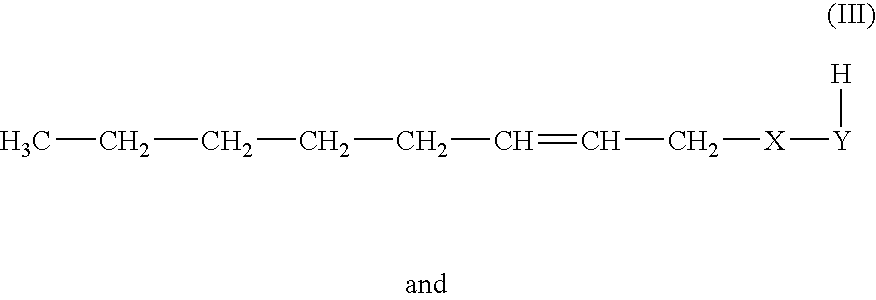Method for producing 1-octene
a technology of octene and octene, which is applied in the field of process for preparing 1octene, can solve the problems of unsatisfactory selectivities in this step and the inability to obtain 1-octene directly, and achieve the effect of high purity and good yield
- Summary
- Abstract
- Description
- Claims
- Application Information
AI Technical Summary
Benefits of technology
Problems solved by technology
Method used
Image
Examples
example 1
Methanol as Telogen, 1-methoxy-2,7-octadiene
[0098]In a 70 l autoclave, 14 kg of methanol, 21 kg of 1,3-butadiene, 7.5 g of palladium(II) acetate, 85 g of triphenylphosphine and 160 g of triethylamine were heated to 80° C. in the absence of water and oxygen. A pressure rise to 8 bar was observed. Under these conditions, the reaction started. The pressure decreased again with the commencement of the reaction of 1,3-butadiene. After 24 hours, the autoclave was cooled to room temperature and the remaining pressure was released. According to GC analysis, 98% of the 1,3-butadiene had reacted. The main products obtained were:
[0099]
ComponentCAS No.Proportion in %Methanol64-56-132.31,3,7-Octatriene1002-35-39.34-Vinylcyclohexene100-40-30.23-Methoxy-1,7-octadiene20202-62-47.81-Methoxy-2,7-octadiene14543-49-848.8Others1.6
[0100]To work up the output from the reactor, it was subjected to a batch distillation at 80 mbar to separate it into a catalyst residue and a distillate.
example 2
Homogeneously Catalyzed Hydrogenation
[0101]1000 g of 1-methoxy-2,7-octadiene, 500 ml of tetrahydrofuran, 500 ml of ethanol and 2.5 g of tris(triphenylphosphine)ruthenium(II) chloride were placed in a 3 l Büchi autoclave. The temperature was set to 30° C. and the autoclave was pressurized to 30 bar by means of hydrogen. The reaction was followed via the amount of hydrogen taken up and by means of GC analyses. After 6 hours, the reaction was stopped. According to GC analysis, 98% of the 1-methoxy-2,7-octadiene had reacted to form 1-methoxy-2-octene (cis and trans) with a selectivity of 89%. The 1-methoxy-2-octene was separated from solvents and catalyst by distillation.
example 3
Heterogeneously Catalyzed Hydrogenation
[0102]A gradient-free differential circulation reactor from Xytel was charged with 15 g of a heterogeneous ruthenium catalyst. To immobilize the catalyst, it was located in a small wire mesh basket. The proportion by weight of ruthenium on the support material λ-Al2O3 was 1% by weight. Before commencement of the reaction, the catalyst was reduced in a hydrogen atmosphere at 200° C. After the reduction, 900 ml of a mixture of trans-1-methoxy-2,7-octadiene and cis-1-methoxy-2,7-octadiene in a mass ratio of 96:4 were introduced into the differential circulation reactor. The reaction mixture was hydrogenated under batch conditions at a hydrogen partial pressure of 10 bar. According to GC analysis, the progress of the reaction at 40° C. was as follows:
[0103]
LHSV−1cis-MOEtrans-MOEcis-MODEtrans-MODEOtherskg h / ltr% by wt% by wt% by wt% by wt% by wt0.00830.131.336.2591.251.040.01670.131.996.1609.331.380.02500.183.056.2088.402.170.03330.234.116.0187.971....
PUM
| Property | Measurement | Unit |
|---|---|---|
| temperatures | aaaaa | aaaaa |
| pressure | aaaaa | aaaaa |
| pressure | aaaaa | aaaaa |
Abstract
Description
Claims
Application Information
 Login to View More
Login to View More - R&D
- Intellectual Property
- Life Sciences
- Materials
- Tech Scout
- Unparalleled Data Quality
- Higher Quality Content
- 60% Fewer Hallucinations
Browse by: Latest US Patents, China's latest patents, Technical Efficacy Thesaurus, Application Domain, Technology Topic, Popular Technical Reports.
© 2025 PatSnap. All rights reserved.Legal|Privacy policy|Modern Slavery Act Transparency Statement|Sitemap|About US| Contact US: help@patsnap.com



